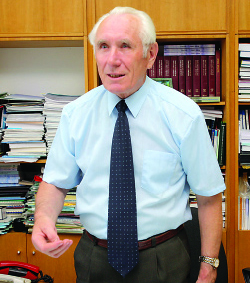 Space programmes are unique instrument for scientific and technical co-operation
Space programmes are unique instrument for scientific and technical co-operation
In the Union State, some joint scientific and technical programmes of space subjects have been successfully carried out. Pyotr Vityaz, a member of the National Academy of Sciences of Belarus, explains what they give to Belarus and Russia and what the prospects of co-operation are. “Above all, the forming of union programmes depends on people who participate in this process. There, where the priority has been chosen rightly, aren’t any questions. The Academy of Sciences of Belarus annually leads from 4 to 6 programmes. Currently we are carrying out four programmes and two programmes have come to the end in the last year. Programmes in the spheres of space and information technologies are one of our priorities. At the bottom, they have become a visiting card of the Union State. We have already carried out 4 programmes on space research. Currently, the Monitoring-SG project is being carried out successfully. The programme is aimed at improving the quality of survey and equipment, of informational technologies and the ‘vitality’ of space satellites. We are solving the problem together with Roscosmos. There are inter-governmental agreements on co-operation. Three meetings of the joint working group, where we have discussed dozens of programmes for the long term, have already been held.
For example, Skif-Nedra, a new programme, should be approved at the meeting of the Union Council of Ministers. The Technologies-SG programme has been also laid down. There are new materials and technologies of space technics. We should also prepare the Standardisation-SG programme, to be able to speak one technical language. It is important not only for Russia and Belarus, but for the whole of international space, for space co-operation. The necessity of extending participation of scientific and industrial organisations of Belarus in union programmes of space sphere is being discussed. About forty percent of scientific and industrial organisations of our country participate in co-operation in the space direction. And, properly speaking, all ministries are consumers of space information. There should be the whole system of monitoring, of improving of the information, the ability to handle it, to set the right task. With 11 ministries, we have created points of reception of space information. First of all, there is Ministry for Emergency Situations, Ministry of Agriculture and Food, Ministry of Forestry, and Ministry of Defence. Aviation and remote-piloted vehicles, which are being also designed today, are used in space research. Innovation technologies and supercomputers are necessarily needed for solving these tasks. Besides, it’s necessary to prepare personnel, so work with universities is being conducted.
July 22nd, 2014, marked two years since the first Belarusian satellite was launched, but it shows up over every point of survey every 16 days. So we can get information regularly; but it’s not enough. Together with the Belarusian satellite of Earth’s remote sensing, ‘Kanopus-B’ Russian apparatus has also been launched. So we have created a grouping of these two satellites. There is a task to extend it. For example, it’s necessary to evaluate productivity, to assess how harvesting is going. So it’s necessary to conduct systematic observations, and it’s advisable to have not less than 12 satellites in orbit to make three hourly monitoring on one or another point. Certainly, we wish to have such a grouping with Russia.
Currently, a lot of consumers want to get space images with the resolution of one metre — for cartography, town-planning and appraisal of property. We are working on it. For two and a half years, with citizens of the Russian Federation we could create, taking into account groundwork and experiences, a new satellite, possessing these necessary characteristics.”
By Vladimir Fedorov











